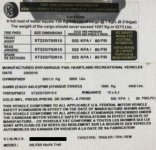The yellow sticker dry weight is the actual weight of the trailer just before it exited the factory floor. If the dealer added anything, that weight may not be included.
GVWR is the maximum weight the trailer is rated for. Fully loaded, including all your gear, water in the tanks, propane, etc. you don't want to exceed GVWR.
The dry weight and hitch or pin weight shown on the Heartland website typically reflect a prototype build of that model with some set of features. But as Heartland makes changes, the weight specs may not be updated. So given that your purchased trailer may have additional options, or changes made since the prototype, you should consider the Dry Weight and Pin Weight to be approximate. The GVWR however, is your top limit.
For most people, it's pretty easy to get loaded up very close to the GVWR, or perhaps even over it. When considering hitch or pin weight, for planning purposes, you should assume the loaded pin weight will be about 20% of the GVWR. So you might assume 2,800 lbs on the hitch once you're loaded up. Compare that to the payload capacity of your truck, usually found on the sticker inside the driver's door frame. Leave margin for the weight of your hitch, bed liner, bed cover, tools, firewood, pets, and passengers.

